Disclosure: Meeple Mountain received a free copy of this product in exchange for an honest, unbiased review. This review is not intended to be an endorsement.
In this review only components from the Tutorial will be shown, although any potential spoilers will be hidden in a collapsible window with a Spoiler alert on it. In all other ways, this review is spoiler-free.
C’est la cité sur toutes couronnée,
Fonteine et puis de sens et de clergie,
Sur le fleuve de Saine située :
Vignes, bois a, terres et praerie.
De touz les biens de ceste mortel vie
A plus qu’autres citez n’ont;
Tuit estrangier l’aiment et ameront,
Car, pour deduits et pour estre jolis,
Jamais cité tele ne trouveront :
Riens ne se puet comparer à Paris.
– Excerpt from the poem Quant j’ay la terre et mer avironnée by Eustache Deschamps (1346-1406)
Riens ne se puet comparer à Paris. Nothing can compare to Paris. In the 21st century, these words perfectly describe how I feel about the city; there is no place in the world that compares to it. That said, I’m not sure I would still feel this way if I travelled back in time to the 1400 Medieval Paris that Deschamps describes. The church bells ringing incessantly to mark the various calls to prayer throughout the day, the crowded and noisy streets bustling with animals and people, the impending threat of Burgundian and English occupation, and the city’s stench that was so bad it forced Charles V to relocate the royal residence outside the old city walls. I think I could probably do without all that, thank you very much.
Chronicles of Crime: 1400 is set during this wonderful time and luckily you get to experience all that the City of Light has to offer before there were lights…and without the smell.
The Chronicles of Crime series of games are cooperative, app-driven crime investigation experiences where players gather as much information as possible before they’re tasked with answering questions about the crime that’s been committed. For each question correctly answered, they’ll earn a number of points and at the end of the game they’ll receive a score out of 100.
Chronicles of Crime: 1400 is a standalone game in the Chronicles of Crime line of games and makes up the first part of the Millennium Series — a series of three games that follows the same crime-solving family over a thousand years, from 1400 to 1900 to 2400. If you’re familiar with the original Chronicles of Crime, you can skip ahead to the 1400 section where I get into what’s new in this game. Otherwise continue reading to learn more about the Chronicles of Crime system.
How the Chronicles of Crime System Works
In the Chronicles of Crime games, players will be visiting different areas of the city, speaking with various individuals, and interacting with objects and locations. All of this is done by scanning QR codes in the game’s app. If a player wants to move from their home to a character’s home, they would scan the QR code on that Location Board. Once there, they could speak to the character — if they were home — by scanning the QR code on their Character Card. And if the character agreed to speak with you, you would enter ‘interrogation mode’ and could scan the QR codes on item cards or other Character Cards to have them tell you about it. You might even want to scan the character’s own Card in interrogation mode to have them tell you about themselves.
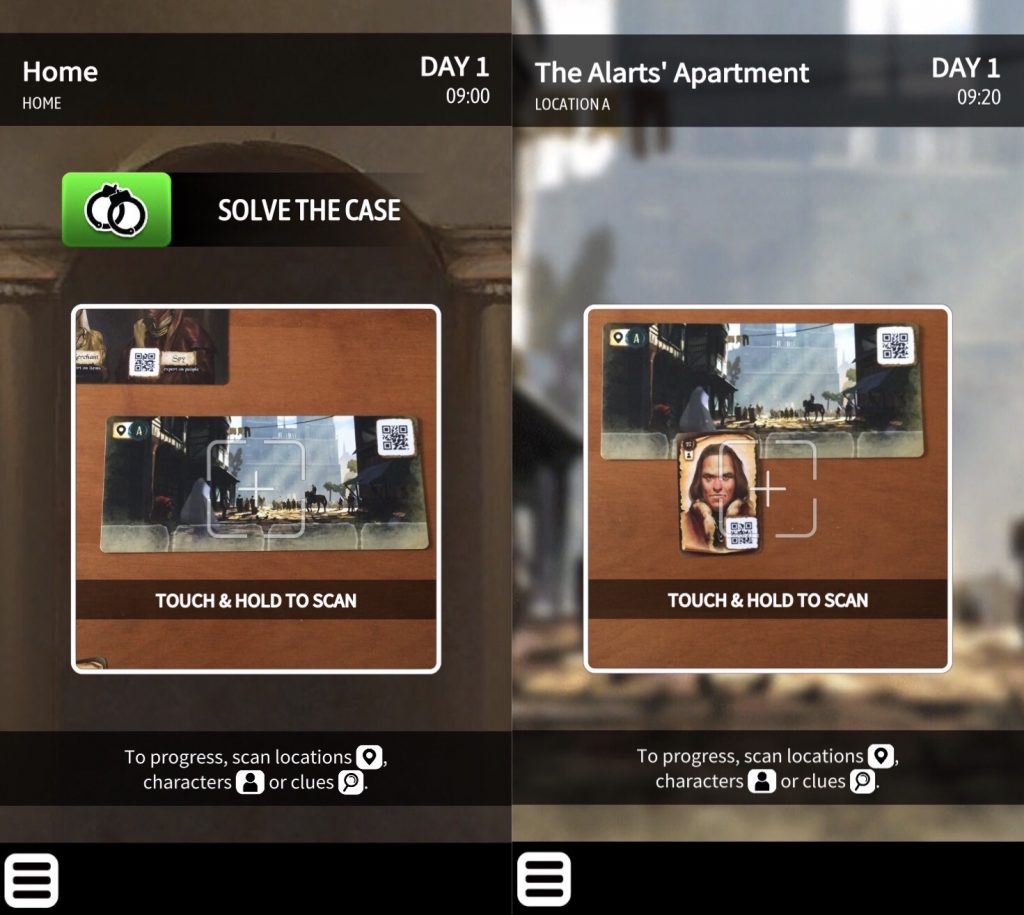
The Chronicles of Crime game boxes are filled with components with QR codes, but players won’t be able to scan willy-nilly and hope to stumble upon helpful information. Much like you would expect in real-life, players must work through the scenario and uncover information, locations, and characters before they’re able to fully interact with any of them. The app clearly instructs players when to take new Location Boards, Character Cards, Evidence Category Cards, and Special Item Cards.
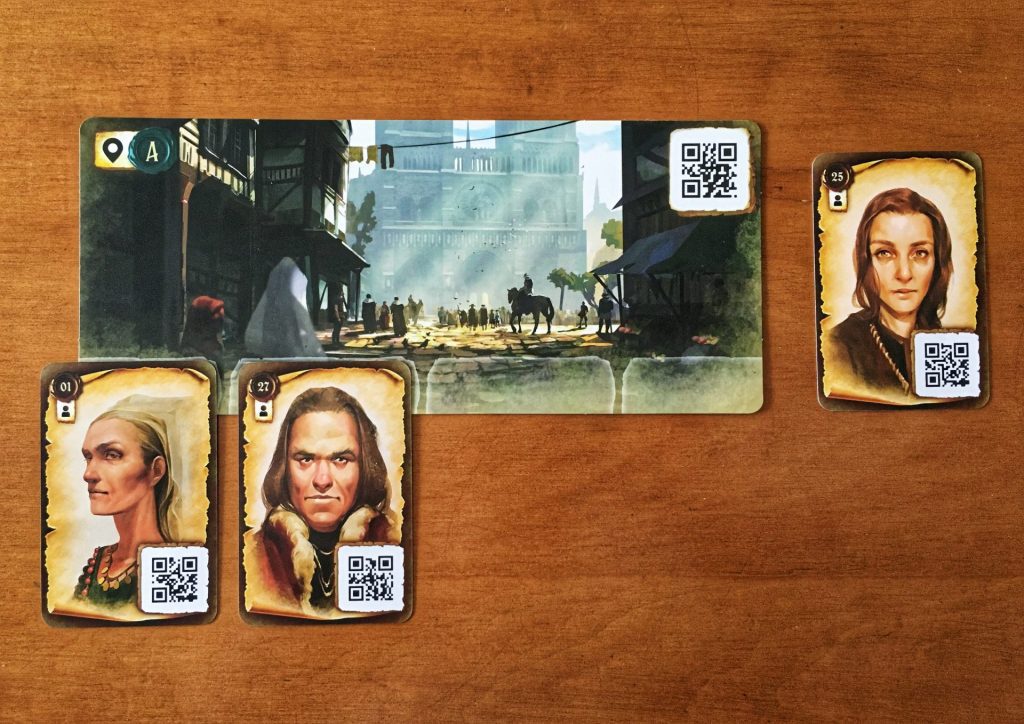
The use of an app in Chronicles of Crime also introduces a new element to this style of investigative game: time. Each QR code scan takes time; 5 minutes is added for searching or for each Character Card or item scan, while 20 minutes is added to the in-game timer to travel to a new location. Time affects the game in two ways. The first is the players’ score: the quicker you solve the case, the more points you earn at the end of the game. The second, and much cooler one, is that the game and its characters actually use the time. If it’s late at night, you’re unlikely to get anywhere if you try visiting a character at home. If someone tells you they need an hour to look into something, you need to give them at least an hour of in-game time before you hope to get any new information.
Time can also affect characters’ locations; maybe you find a character hanging out at home, but after speaking with you, they decide to take off. Now they’re on the run and any hope you had of interrogating them later in the game is lost unless you find them.
Additionally the app’s in-game timer can trigger events. Perhaps an item has been stolen, another murder has been committed, or maybe a character is willing to talk to you after an intimidating character paid them a nightly visit. The passage of time in Chronicles of Crime really helps create an immersive experience that games in this genre cannot replicate with only the use of plastic and cardboard components.
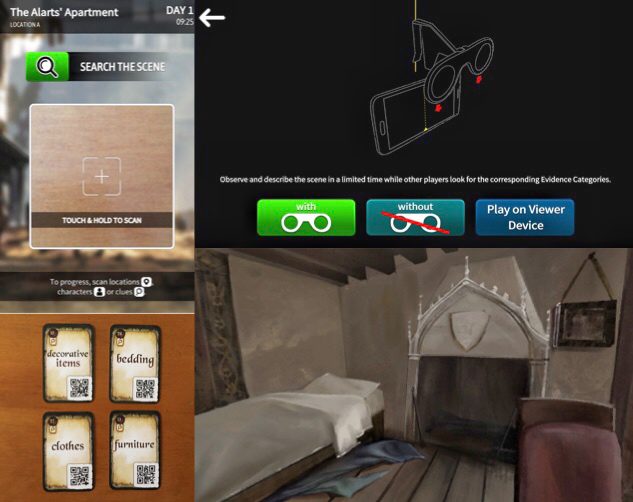
Another thematic element the Chronicles of Crime app creates are crime scenes. In the app, players are transported to a 360° scene of a crime and are able to look around for clues. During a “search”, the player viewing the scene describes what they see while the other players go through the physical deck of Evidence Category Cards (read: items) and set aside any that feel relevant. After the search, players can scan the QR codes on the selected cards to learn more and possibly gain material evidence. (I should note that Lucky Duck Games sells add-on VR glasses that can be used to view the scenes in 3-D to create an even more realistic scene, but they aren’t necessary to play any of the games.)
Chronicles of Crime: 1400 – Bienvenue à Paris
Chronicles of Crime: 1400 consists of one tutorial and four independent game scenarios (unfortunately at the time of writing, one of the scenarios still remains unavailable). The tutorial is fantastic: it will teach you how to play the game (if you’ve never played anything in the Chronicles of Crime family) and it will also help experienced players learn what’s new in the 1400 game — so don’t skip it. Additionally, there is a case for players to solve. Of course, there is still a rulebook if players prefer to learn the game in this way.

In Chronicles of Crime: 1400, players play as Abelard Lavel, a knight sworn to King Charles VI (the Beloved and later the Mad). Abelard has an unusual gift; each scenario begins with Abelard having a prophetic dream about the case you’ll be solving. Mechanically, the app instructs players to take a number of Vision Cards from the deck and put them faceup on the table. These Vision Cards depict scenario-specific scenes from the future or past and often involve characters or items you’ll encounter during the scenario. While players may reference these at any point during the scenario (and infer what they will from them), none of the Cards have QR codes so you won’t be able to ask characters about them.
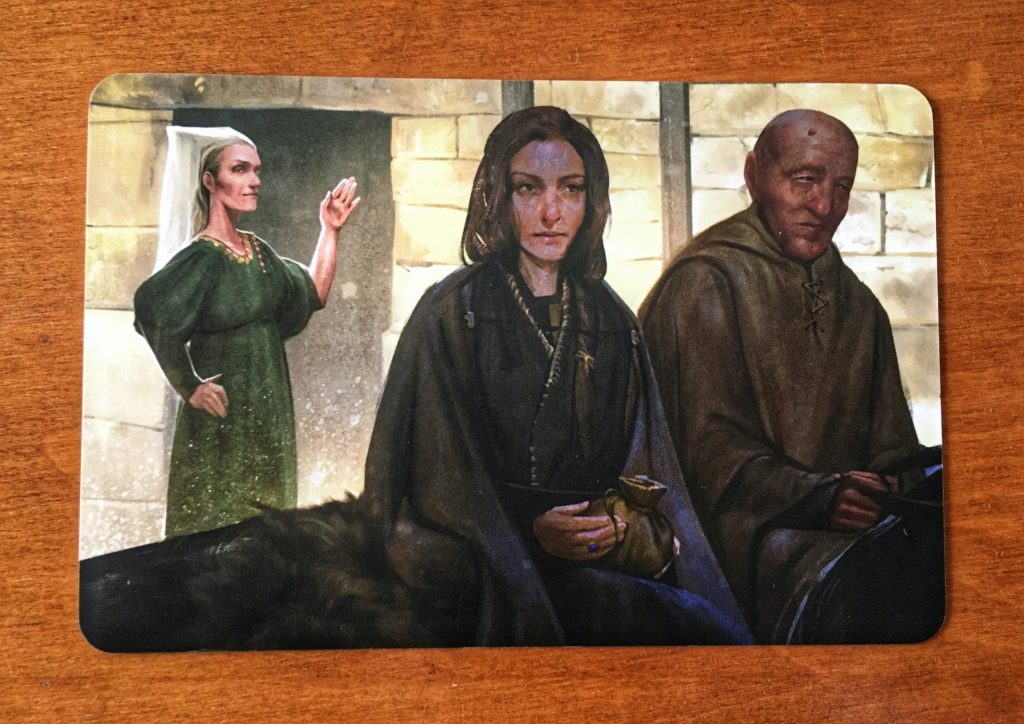
To help you in your scenario, you’ll have four family members at your disposal: your uncle the monk, your sister the merchant, your brother the king’s spy, and your dog Perceval.
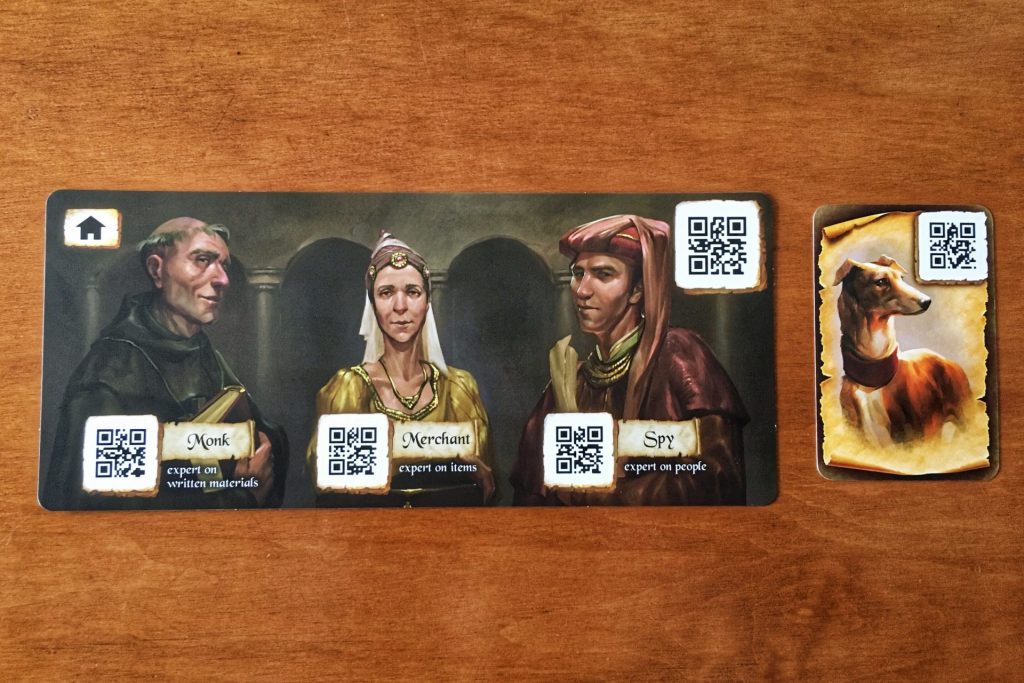
The human members of your family have an area of expertise — Uncle Monk’s is written resources/religious items, Sister Merchant for other items, and Brother Spy knows all about the important Parisian people. They will help you out whenever you ask for it (by scanning their QR codes). If you’re familiar with the original Chronicles of Crime, these are like the Forensic Contacts.
Your dog Perceval’s area of expertise is, well, being a dog. He is a faithful companion and will follow you around to any location you visit, and he can use his nose to help you sniff out objects and track scents. To do so in a scenario, players can scan Perceval’s QR code and then scan the QR code of an item they found (like a dress, for example). Perceval will then react in one of four ways:
- Ignore the object because there’s no recognizable human scent.
- Get agitated by the smell because there is a strong human scent, but he’s not able to track it at the moment.
- Point to the character in question if they are present in your current location.
- Lead you to a location where the person in question is (or was recently…remember time is of the essence in Chronicles of Crime).
Other than these few things, Chronicles of Crime: 1400 plays very similarly to its predecessors; players will still encounter time-specific events and make gameplay decisions throughout a scenario that could have an effect on their score. There also doesn’t seem to be a connection between each scenario so you could choose to play them in any order (although I’d recommend sticking to playing them in their order of difficulty).
Final Thoughts
Before I get into my final thoughts you should know, dear reader, that Chronicles of Crime will always hold a special place in my heart, especially in the context of Meeple Mountain. Just under three years ago, I participated in my first board game play/beta testing (Chronicles of Crime) and I also applied to write for Meeple Mountain. As part of my application, along with some nonsense that included a story about an awkward lunch in Quimper, I submitted a review of Chronicles of Crime.
Much of that review’s content was included in Meeple Mountain’s Chronicles of Crime preview that Phil Chen and I co-authored. What stood out to me then about Chronicles of Crime was how seamlessly the app integration worked with the physical board game to create a thematic and immersive investigative experience, as well as how brilliant the application of time was in the game — and how that meant the game’s designers could play with different elements previously unexplored in this genre. As I played more cases in the original game and its expansions, these feelings persisted…and Chronicles of Crime: 1400 is no exception. As long as games released in the Chronicles of Crime universe continue to use and build upon the original game’s system, I will continue to enjoy playing them.

With Chronicles of Crime: 1400, I didn’t find there were too many changes and additions from the original base game. The most important ones, though, are your dog Perceval and the Vision Cards. Not only is Perceval incredibly helpful when you’re trying to literally sniff out liars or track down suspected individuals, but it felt like it worked thematically too. Without fancy 21st century technology and big investigative teams, how else might you successfully track someone down? The Vision Cards are neat because you receive them at the start of the scenario so you can carefully note the physical appearance of the characters in them and the little details on objects/in the scene. Then when you interact with one of these characters later in the game, for example, you can start to understand the context of the Vision Card and begin to speculate about what was taking place.
Something I did miss when playing Chronicles of Crime: 1400 was the use of Action Cards (introduced in Noir), but 1400 does still try to incorporate some ways in which you can use money to essentially bribe people. It didn’t quite feel the same, but I suspect not including them was more of a thematic choice for the 1400 setting. (If you’ve only played Chronicles of Crime and never played Noir, you won’t notice anything is missing from your gameplay. If you’ve never played either, I suspect you’ll be impressed with these mechanisms more than anything.)
Finally I want to talk about the game’s setting. I’m not quite sure what I expected from a game set in the 1400s, but there was a big focus on church/religion and I think I wanted more gameplay around the state/political aspect of the times. (Mind you, I suppose the two were tied closely together back then.) I also wanted more Paris! Sure, there were many times Île de la Cité and Notre-Dame were referenced, but I wanted something unexpected like Charles VI running around the Hôtel Saint-Pol. I wasn’t necessarily disappointed with how the setting was used, but it didn’t draw me in either — unlike the setting in the original Chronicles of Crime or its expansion, Noir.
So where does Chronicles of Crime: 1400 land? If you’ve never played a game in the Chronicles of Crime family, I would recommend starting with the original Chronicles of Crime over Chronicles of Crime: 1400 — unless of course that 1400s vibe really appeals to you. If you didn’t like the original game, I doubt 1400 will change your mind; there aren’t enough new changes and additions to it.
However, if you’re a big fan of the Chronicles of Crime games like I am, Chronicles of Crime: 1400 is a must. With it you are getting all that Chronicles of Crime goodness with some new gameplay elements (like Perceval). Moreover, now that I’ve played through it, I’m excited to see the family’s journey over the next millennium and how the decisions the Lavel family made in the 1400s will carry over and affect their descendants in the 1900s and 2400s. But most importantly, I cannot wait to see how the designers incorporate the evolution of beautiful Paris over that time into the game.
Rien ne se peut comparer à Paris. Rien ne se peut comparer à Chronicles of Crime.
Thematic Music for Playing Chronicles of Crime: 1400
At the time of the Chronicles of Crime: 1400 app’s release for reviewers, no in-app music was available yet. However, Lucky Duck Games never lets me down so I would recommend turning the in-app music right up when you start playing your copy of Chronicles of Crime: 1400.


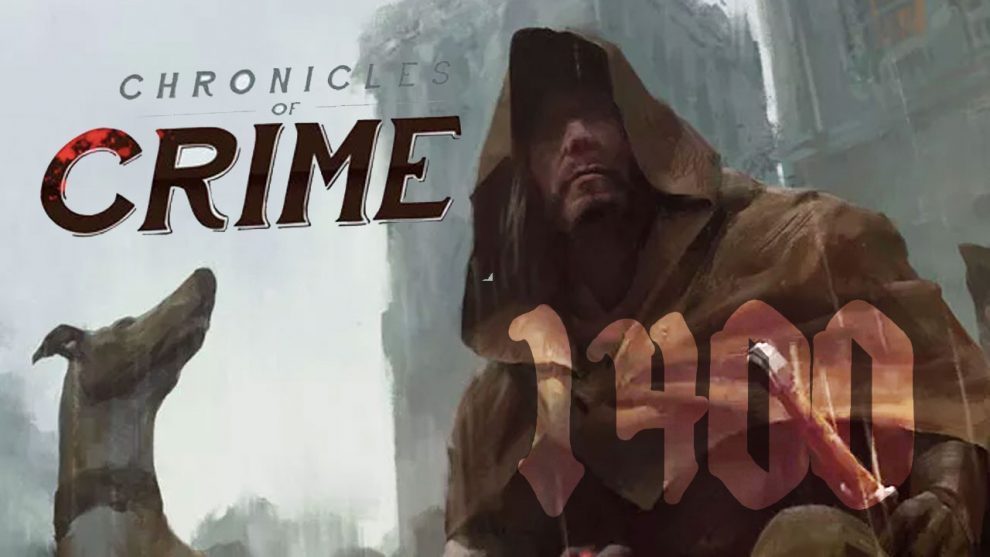


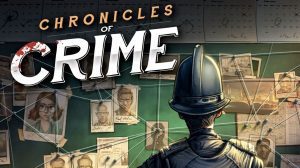

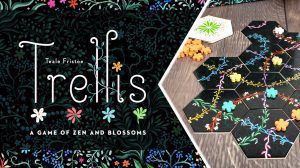




Add Comment